More:
Events
DesAIgn
An international conference on the implications of artificial intelligence
on the field of design
May 25, 2021, 9:30 am - 7:00 pm (CET) (online)
https://design.hit.ac.il/desaign
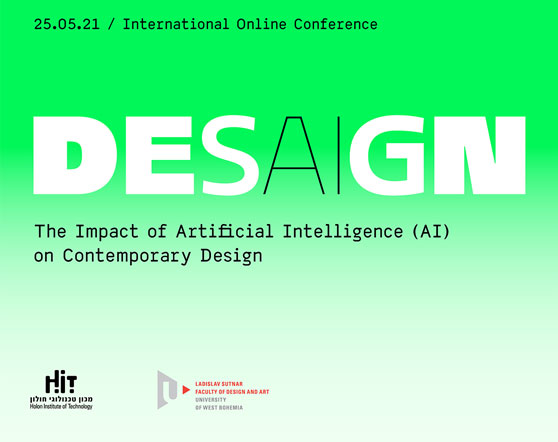
The field of artificial intelligence (AI) is gradually penetrating the various design disciplines and enabling machines to perform tasks that were previously the exclusive domain of human designers. Recently developed AI-based applications can generate designs at a speed and variety that humans cannot accomplish. They can create synthetic images, design furniture, sketch architectural plans, invent fonts, and develop marketing campaigns. In addition, AI systems are capable of tackling complex problem-solving challenges, making behavioral predictions, and connecting between variables from different areas. Implemented at both the design and fabrication stages, they address the two key components of design: the aesthetic and the functional.
The DesAIgn conference, dedicated to exploring the implications of the use of artificial intelligence in design, is co-organized by the Faculty of Design at the Holon Institute of Technology (HIT) in Israel, and the Ladislav Sutnar Faculty of Design and Art at the University of West Bohemia in the Czech Republic. The international conference will host scholars and designers from France, the Netherlands, Serbia, the UK, the United States, Japan, the Czech Republic, and Israel. It seeks to examine both the potential and challenges associated with the assimilation of artificial intelligence platforms into the field of design, as well as the broad theoretical, aesthetic, and practical implications of this kind of integration. Issues under discussion will include: Changes in the role of the designer and the concept of creativity in an era when machines become autonomous; Political and sociological implications of the use of artificial intelligence algorithms; Infrastructures that facilitate working with AI systems; and more.
Conference Keynotes
1. Prof. Vladan Joler, (Novi-Sad, Academy of Art, RS)
Lecture title: "Anatomy of an AI System".
Abstract: The lecture covers the invisible matrix of human labour, energy consumption and resource extraction that is hidden behind digital networks and Artificial Intelligence. Specifically, it takes the home assistant Amazon Echo as a case study of black box technology and, step by step, reconstructs its design and the relations of each of its components with planetary ecology and economy.
The lecture will also refer to Joler's project New Extractivism which captures the contemporary forms of exploitation related to connectivity and networked infrastructures. It consists of a map and a manual followed by footnotes that depict and describe different concepts and allegories linking old to new forms of colonialism. The ideas, things and people presented together on the map and the manual are approached as an assemblage that express what extractivism today is and depends upon; they refer to the mining of data but also of natural resources, and to the labour of human but also of nonhuman agents, highlighting their interconnection. The work pays special attention to earth labour and geological processes that power the engines of new extactivism, and also presents the impact of the continuous data accumulation on the body of the planet. It discusses how the furthest corners of the biosphere are affected while new data economies are being born maximizing profit for a few.
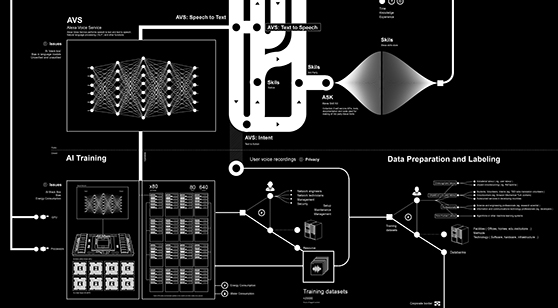
Vladan Joler and Kate Crawford, Anatomy of an AI System, detail
Short bio: Prof. Vladan Joler is an academic, researcher and artist whose work blends data investigations, counter cartography, investigative journalism, writing, data visualization, critical design, and numerous other disciplines. He explores and visualizes different technical and social aspects of algorithmic transparency, digital labour exploitation, invisible infrastructures, and many other contemporary phenomena in the intersection between technology and society.
In 2018, in cooperation with Kate Crawford, he published Anatomy of an AI System, a large-scale map and long-form essay investigating the human labour, data, and planetary resources required to build and operate an Amazon Echo. His previous investigation Facebook Algorithmic Factory, included deep forensic investigations and visual mapping of the algorithmic processes and forms of exploitation behind the largest social network. Other investigations, he authored, published in recent years by the independent research collective, SHARE Lab included research on information warfare, metadata analysis, browsing history exploitation, surveillance, and internet architecture. He curated and organised numerous events and gatherings of internet activists, artists, and investigators including SHARE events in Belgrade and Beirut. His artistic pre-history is rooted in media activism and game hacking.
Vladan Joler’s work is included in the permanent collections of the Museum of Modern Art (MoMA) in New York City, the Victoria and Albert Museum in London and included in the permanent exhibition of Ars Electronica Center. His work is exhibited in more than a hundred international exhibitions, including institutions and events such as: ZKM, XXII Triennale di Milano, HKW, Vienna Biennale, V&A, Transmediale, Ars Electronica, Biennale WRO, Design Society Shenzhen, Hyundai Motorstudio Beijing, MONA, Glassroom, La Gaite Lyrique and institutions such as Council of Europe in Strasbourg and European Parliament in Brussels.
He has received numerous awards, including the 2019 Design of the Year award by the Design Museum in London and S+T+ARTS Prize ’19 Honorary mention by the European Commission and Ars Electronica. Joler’s work has been profiled and covered in many international media such as BBC, CNN, WIRED, The Independent, The Times, Wallpaper*, Le Figaro, The Verge, Fast Company, +ARCH, ArtForum, Neural, LesJours, WeMakeMoneyNotArt and many others.
2. Arch.Stanislas Chaillou's, (an Architect & Sr. Data Scientist at Spacemaker’s R&D department, FR)
Lecture Title: AI & Architecture, Towards a New Approach
Abstract: Artificial Intelligence (AI) has already made its way into countless industries, providing them with the means to meet new challenges. Its use in the field of architecture is still in its infancy, but current results and expected outcomes are promising. This technology represents much more than a mere opportunity, it is without doubt a decisive step forward, quite capable of transforming the architectural practice.
Bringing together concrete examples and recent results achieved in various fields of research, we present a landscape of AI’s presence in architecture and a panorama of the latest advances in this field. Architectural plans, elevations, perspectives, structures: as many scales to which AI can already contribute. Between current theory and experimentations, we intend to shed light on the inception of a new technological era, leveraging the architectural practice, while offering it a renewed relevance.
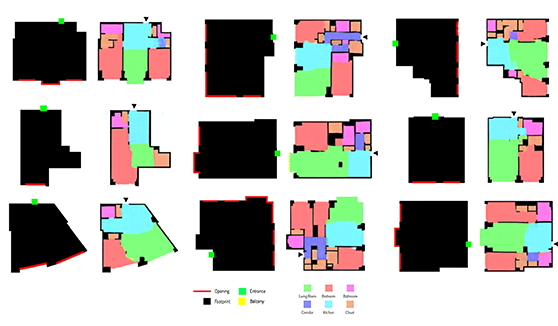
Stanislas chaillou, Results: Generated Program & Fenestration
Short bio: A Paris native, Stanislas received his undergraduate degree in Architecture at the Swiss Federal Institute of Technology of Lausanne, and his Master’s in architecture from the Harvard Graduate School of Design. Focusing his practice on Architecture and Artificial Intelligence, he believes in the necessary integration of both disciplines to change our built environment. Stanislas works today as an Architect & Sr. Data Scientist at Spacemaker’s R&D department. He is in charge of developing AI research projects, to assist and enhance architectural conception. Stanislas has lectured widely, at Harvard, the MIT Media Lab, the Sorbonne University, ETHZ, EPFL, l’Ecole Nationale des Ponts et Chaussées and others.
Stanislas was awarded two American Architecture Prizes (2017) and the Architecture Masterprize (2018). He also received the 2018 ZGF scholarship for his past architectural work. He is a Fulbright scholar, an Arthur Sachs Fellow and Jean Gaillard Fellow at Harvard University.
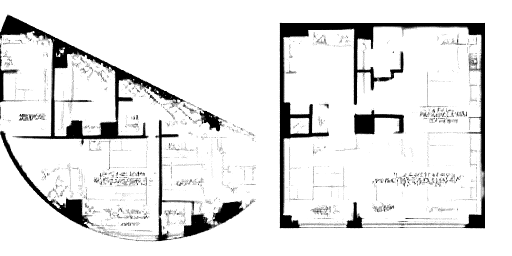
Stanislas chaillou, GAN-enabled Space Layout under Morphing Footprint
3. Anouk Wipprecht , (fashion-tech- designer, NL/USA)
Lecture title: FashionTech A.I. Futures
Abstract: Fashion becomes interactive and technology has never before been as close to the skin – what kind of possibilities does this open up? Anouk Wipprecht is a FashionTech designer who works interdisciplinary in search for intelligent systems that interact with the body as the environment of the wearer. Wipprecht uses machine learning, A.I. and biomimicry coupled to sensors and animatronics. Her designs move, breath, and react to the world around them. She is interested in new ways we can interface — and builds micro-controlled garments to provoke her generation.

Anouk Wipprecht, Spider Dress
Short bio: Anouk Wipprecht is a Dutch FashionTech Designer, Engineer, and Innovator living in Miami. She is working in the field of wearable robotics with a focus on behavioral aspects of the interactions of body-based electronic design. She wants her garments to facilitate and augment the interactions we have with ourselves and our surroundings. Her Spider Dress is a perfect example of this aesthetic, where sensors and moveable arms on the dress help to create a more defined boundary of personal space while employing a fierce style.
Partnering up with companies such as Intel, AutoDesk, Google, Arduino, Microsoft, Samsung, Adobe, Adidas, Cirque Du Soleil, Audi, Disney, Swarovski, and 3D printing company Shapeways she researches how our future would look as we continue to embed technology into what we wear, and more importantly – how this will change our perspective on how we will interface with technology.
Over the years, her designs have received recognition and attention via exhibitions, publications, and awards. Wipprecht's work has been exhibited internationally at multiple International Fashion Weeks, during CES and Art Miami, Premiere Vision Paris, ARS Electronica Festival, IAA and more. Her work has been featured in magazines like WIRED, Vogue, Elle, IEEE Spectrum, with TV appearances on CNN, Discovery Channel, Red Bull TV and NFL and exhibitions of her dresses at museums like V&A Museum, ARS Electronica Center, VITRA Museum, and the Museum for Science and Technology amongst a few.
Special lecture: Current developments in AI
Another lecture, given by Dr. Eyal Gruss, will review current developments in the field of artificial intelligence, demonstrating how these innovations are implemented in different projects in the field of design.
Dr. Eyal Gruss is a new-media artist and machine learning researcher with a PhD in physics. His works include interactive installations, computer-generated art, algorithmic poetry, audio-visual performances, AI art, and online interventions. He has participated in many conferences and new-media events worldwide.
Panels
Four panels of short lectures (20 minutes each) by scholars and designers who responded to the CFP and were selected by the conference committee will explore different aspects of the incorporation of AI into design:
The first panel will refer to social and political related to the integration of artificial intelligence systems into design processes. Designer Mushon Zer Aviv (Shenkar, Israel), and Sarah Pagliaccio (Independent Designer, USA) will present their papers.
The second panel will examine different strategies of using artificial intelligence in design processes. This panel will include: Dr. Lior Zalmanson (Tel Aviv University, Israel), Dr. Carolina Kotnor (University of Technology in Prague, Czech Republic) and Dr. Rumi Mykolinsky, Tom Reznikov (Bezalel, Israel) and Yuri Kalbanov (University of Tokyo, Japan) who will present a joint project of the Bezalel Academy and the University of Tokyo.
The third panel will relate to the ways in which the concepts of consciousness, authenticity and intelligence are reflected in design processes based on artificial intelligence. This panel will feature lectures by Dr. David Faitelson (Afeka Academic College, Israel), Arch. Des Pegan (Lancaster University, UK) and Arch. Maria Tsilogianni (Coventry University, UK).
The fourth panel will explore the concept of 'agency' in the context of AI. The panel will include lectures by Arch. Malgorzata Starzynska (Royal Academy in London, UK) and Prof. Alexander Webb (University of New Mexico, USA).
Conference Chairs
Dr. Yael Eylat Van Essen, Master's Program in Design, HIT- Holon Institute of Technology, Israel
Dr. Arnost Marks, Director of the Institute of Interdisciplinary Studies of Art, Design and Advanced Technologies (IAT), Ladislav Sutnar Faculty of Design and Art, University of West Bohemia, Czech Republic.
The conference will be held in collaboration with the AI 2.0 conference on artificial intelligence and industry organized by the Department of Computer Science at the Holon Institute of Technology. It will take place on May 24, 2021 | https://design.hit.ac.il/ai2/
Further Information:
Participation in the conference is free
Conference website: https://design.hit.ac.il/desaign
For more information about the conference: yaeleylat@gmail.com, arnost.marks@gmail.com
The organizers of the conference thank the French Institute and the French Embassy in Israel for supporting the participation of Arch. Stanislas Chaillou in the conference.

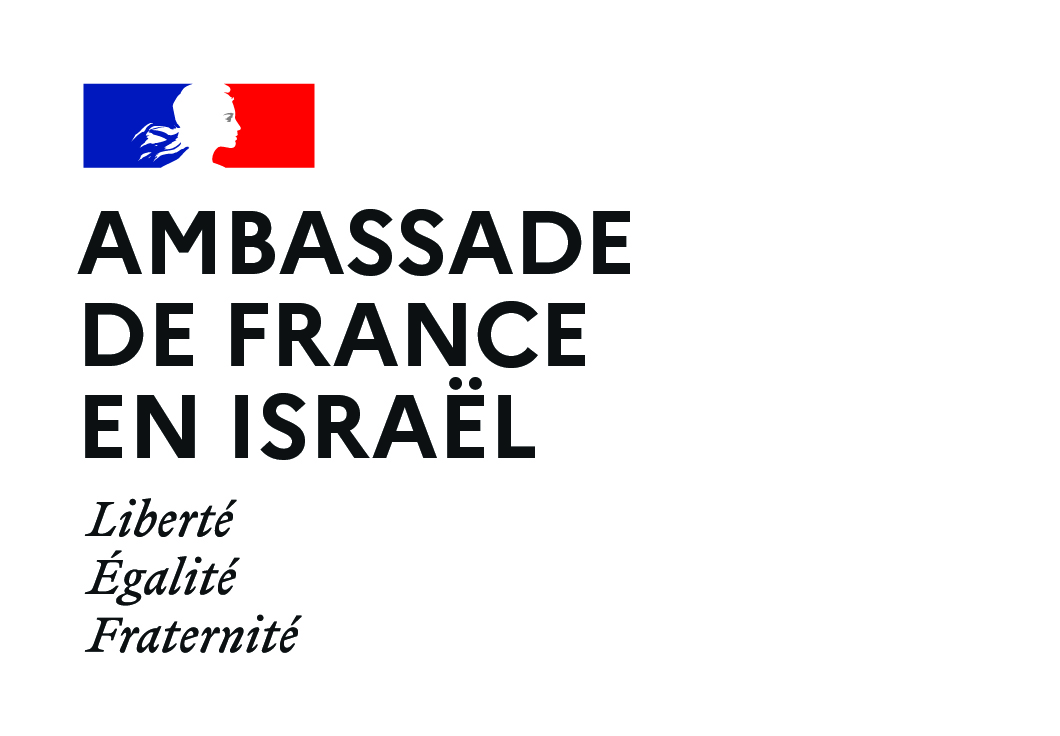
Registration
Posted: 09/05/2021
- News & Events
International Week of Interdisciplinary Studies and Academic Collaborations in Crete
A substantial delegation of 16 students and four faculty members from HIT Holon Institute of Technology participated in week-long international activities and events at HMU-Hellenic Mediterranean University in Crete. ...


 Additional programs
Additional programs
